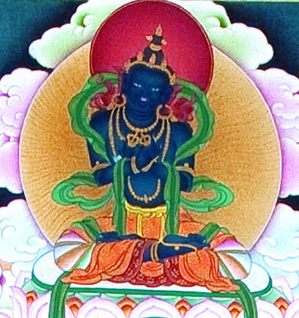Vajrayana

Vajrayana (Skt. vajrayāna; Tib. རྡོ་རྗེ་ཐེག་པ་, dorje tekpa, Wyl. rdo rje theg pa) or 'Vajra Vehicle'. The teaching, and practice, of the Vajrayana or ‘Secret Mantra Vehicle’ lies at the heart of the Mahayana Buddhist tradition of Tibet. Based on the motivation of bodhichitta—the wish to attain, for the sake of others, the state of complete enlightenment—the Vajrayana is a path centred on cultivating pure perception. It contains many powerful methods for accumulating merit and wisdom, in order to arrive swiftly at a direct realization of buddha nature and the nature of reality itself. Through the practices of visualization, mantra recitation and meditation, ordinary perception is transformed into a ‘sacred outlook,’ where everything is seen and experienced purely in its true nature.
It is important to remember that all these methods are merely skilful means, not the goal itself. As His Holiness the Dalai Lama says, “Buddhism is not about rituals, mantras, visualizations, or ceremonies. They may be part of it, but the fundamental point of Buddhism is to transform the mind.” He also explains that the word ‘mantra’ in Secret Mantrayana means ‘that which protects the mind.’ Here, mantra protects the mind against ordinary perception. This is also the real meaning of ‘vajra’ in the word ‘Vajrayana.’
The Vajrayana is not a separate vehicle from Mahayana, but actually belongs within Mahayana as a distinctive vehicle of skilful means.
The Four Distinguishing Features of the Vajrayana
Although the Sutrayana and Mantrayana both have as their ultimate goal the attainment of perfect buddhahood, the Mantrayana differs from the Sutrayana in the way that goal is attained. There are four distinguishing features[1] that make it superior:
- the unobscured view,
- the many methods of meditation,
- the action that is without difficulty and
- the extremely sharp faculties of the individual.[2]
As it says in The Torch of the Three Methods:
ཐབས་མང་དཀའ་བ་མེད་པ་དང༌། །
དབང་པོ་རྣོན་པོའི་དབང་བྱས་པས། །
It has the same goal but is free from all confusion,
It is rich in methods and without difficulties.
It is for those with sharp faculties.
The mantra vehicle is especially sublime.
Notes & References
- ↑ Jamgön Kongtrul & Jokyab Rinpoche also mention six, seven, or twelve ways in which the Mantrayana is superior to the Sutrayana. See The Light of Wisdom Vol. One, translated by Erik Pema Kunsang (Boudhanath: Rangjung Yeshe Publications, 1999), pages 154 & 280.
- ↑ Khenpo Ngawang Pelzang, A Guide to the Words of My Perfect Teacher (Boston & London: Shambhala, 2004), page 31
Oral Teachings Given to the Rigpa Sangha
- Khandro Rinpoche, Rigpa Berlin Centre, 17-18 April 2012, 'The Vajrayana Tradition of Tibet - An Introduction'
- Sogyal Rinpoche, Lerab Ling, 26 June 2004, 12.00
- Sogyal Rinpoche, Lerab Ling, 23 July 2004, 11.45
Edited Teachings of Sogyal Rinpoche
- Ngöndrolink December 2005, The Essence of the Vajrayana, Lerab Ling, 19 July 2005 (available in English, French and German, CDE 440)
- Ngöndrolink October 2004, The Attitude of Secret Mantrayana, Haileybury, 7 April 2004 (available in English, French and German, CDE 434)
- Rigpalink August 2004, Releasing the Energy of Wisdom and Compassion, London, 28 June 2004 & Lerab Ling, 12 July 2004 (available in English, French and German, CDE367)
Further Reading
- A Guide to Vajrayana Practice for the Rigpa Sangha (Lodève: The Tertön Sogyal Trust, 2006), Section 1. 'Introduction'
- Jamgön Kongtrul, The Treasury of Knowledge, Book Eight, Part Three: The Elements of Tantric Practice, Snow Lion, 2008, ISBN 978-1559393058
- Jamgön Kongtrul, The Treasury of Knowledge, Book Eight, Part Four: Esoteric Instructions, A Detailed Presentation of the Process of Meditation in Vajrayana, Snow Lion, 2007, ISBN 978-1559392846
- Jamgön Kongtrul, Creation and Completion: Essential Points of Tantric Meditation, Wisdom Publications, 2002, translated by Sarah Harding, ISBN 978-0861713127
- Khenpo Ngawang Pelzang, A Guide to the Words of My Perfect Teacher (Boston & London: Shambhala, 2004), page 5 and ‘1.2. Vast Skill in Means: The Attitude of the Secret Vidyadhara Mantrayana’, pages 31-34.
- Longchen Yeshe Dorje, Kangyur Rinpoche and Jigme Lingpa, Treasury of Precious Qualities Book Two (Boston & London: Shambhala, 2013), Chapter 10: 'The Teachings of the Vidyadharas'
- Padmasambhava & Jamgön Kongtrul, The Light of Wisdom Vol. One, translated by Erik Pema Kunsang (Boudhanath: Rangjung Yeshe Publications, 1999), pages 152-155.
- Patrul Rinpoche, The Words of My Perfect Teacher (Boston: Shambhala, Revised edition, 1998), ‘1.2 Vast Skill in Means: The Attitude of the Secret Mantrayana', pages 8-10.
- Sogyal Rinpoche, The Nine Yanas, from Dzogchen & Padmasambhava, republished in 2004 by Zam. Available here
- Tulku Thondup, Masters of Meditation and Miracles, edited by Harold Talbott (Boston: Shambhala, 1999), page 10.
- Thinley Norbu, The Small Golden Key (Shambhala Publications, 1999), ‘6. The Superiorities of Mahayana and Vajrayana’, pages 35-37.